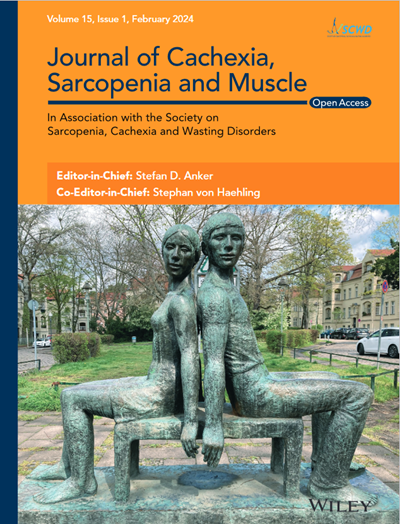利用常规ct分期全自动体成分分析肺癌患者生存预后的探讨。
IF 9.1
1区 医学
引用次数: 0
摘要
背景:人工智能驱动的自动身体成分分析(BCA)可以提供来自常规分期ct的定量预后生物标志物。这项双中心研究评估了这些体积指标对肺癌患者总生存期的预后价值。方法来自A医院的肺癌队列(n = 3345,中位年龄65岁,86% NSCLC, 40% M1, 40%女性)和B医院的肺癌队列(n = 1364,中位年龄66岁,87% NSCLC, 37% M1, 38%女性)在初次诊断后±60天进行了腹部ct自动BCA。深度学习网络对肌肉、骨骼和脂肪组织(内脏= VAT,皮下= SAT,肌内/肌间= IMAT和总= TAT)进行分割,得出三个标记:肌少症指数(SI =肌肉/骨骼),肌增脂指数(MFI = IMAT/TAT)和腹部脂肪指数(AFI = VAT/SAT)。进行Kaplan-Meier生存分析、Cox比例风险建模和基于机器学习的生存预测。包括临床数据(BMI、ECOG、L3-SMI、-SATI、-VATI和-IMATI)的生存模型拟合在A医院的数据上,并在B医院的数据上进行验证。结果在非转移性非小细胞肺癌中,高SI预示着跨中心男性患者更长的生存期(A医院:24.6个月vs 46.0个月;B医院:13.3个月vs. 28.9个月;p < 0.001)和女性(A医院:37.9 vs. 53.6个月,p = 0.008;B医院:23.0 vs 28.6个月,p = 0.018)。高MFI表明两家医院男性患者的生存率降低(A医院:43.7 vs 28.2个月;B医院:28.8个月对14.3个月;均p≤0.001),但女性存在中心依赖效应(仅在A医院显著,p < 0.01)。在转移性疾病中,SI仍然是两个中心男性的预后因素(p < 0.05),而MFI仅在A医院(p≤0.001)和AFI仅在B医院(p = 0.042)具有显著意义。多因素Cox回归证实,较高的SI具有保护作用(A: HR 0.53, B: 0.59, p≤0.001),而MFI与较短的生存期相关(A: HR 1.31, B: 1.12, p < 0.01)。基于A医院数据训练的多变量生存模型在内部(n = 209, p≤0.001)和外部(B医院,n = 361, p = 0.044)验证中显示了各组的预后分化,SI特征重要性(0.037)低于ECOG(0.082)和m状态(0.078),优于所有其他特征,包括常规l3单片测量。结论基于ct的体积BCA可作为肺癌的预后生物标志物,在不同性别、疾病分期和中心有不同的意义。SI是最强的预后指标,优于传统的基于l3的测量,而脂肪相关指标显示出不同的相关性。我们的多变量模型表明,BCA标记物,特别是SI,可能会增加肺癌的风险分层,有待中心特异性和性别特异性的验证。将这些标记整合到临床工作流程中,可以为高危患者提供个性化护理和有针对性的干预措施。本文章由计算机程序翻译,如有差异,请以英文原文为准。
Exploration of Fully-Automated Body Composition Analysis Using Routine CT-Staging of Lung Cancer Patients for Survival Prognosis.
BACKGROUND
AI-driven automated body composition analysis (BCA) may provide quantitative prognostic biomarkers derived from routine staging CTs. This two-centre study evaluates the prognostic value of these volumetric markers for overall survival in lung cancer patients.
METHODS
Lung cancer cohorts from Hospital A (n = 3345, median age 65, 86% NSCLC, 40% M1, 40% female) and B (n = 1364, median age 66, 87% NSCLC, 37% M1, 38% female) underwent automated BCA of abdominal CTs ±60 days of primary diagnosis. A deep learning network segmented muscle, bone and adipose tissues (visceral = VAT, subcutaneous = SAT, intra-/intermuscular = IMAT and total = TAT) to derive three markers: Sarcopenia Index (SI = Muscle/Bone), Myosteatotic Fat Index (MFI = IMAT/TAT) and Abdominal Fat Index (AFI = VAT/SAT). Kaplan-Meier survival analysis, Cox proportional hazards modelling and machine learning-based survival prediction were performed. A survival model including clinical data (BMI, ECOG, L3-SMI, -SATI, -VATI and -IMATI) was fitted on Hospital A data and validated on Hospital B data.
RESULTS
In nonmetastatic NSCLC, high SI predicted longer survival across centres for males (Hospital A: 24.6 vs. 46.0 months; Hospital B: 13.3 vs. 28.9 months; both p < 0.001) and females (Hospital A: 37.9 vs. 53.6 months, p = 0.008; Hospital B: 23.0 vs. 28.6 months, p = 0.018). High MFI indicated reduced survival in males at both hospitals (Hospital A: 43.7 vs. 28.2 months; Hospital B: 28.8 vs. 14.3 months; both p ≤ 0.001) but showed center-dependent effects in females (significant only in Hospital A, p < 0.01). In metastatic disease, SI remained prognostic for males at both centres (p < 0.05), while MFI was significant only in Hospital A (p ≤ 0.001) and AFI only in Hospital B (p = 0.042). Multivariate Cox regression confirmed that higher SI was protective (A: HR 0.53, B: 0.59, p ≤ 0.001), while MFI was associated with shorter survival (A: HR 1.31, B: 1.12, p < 0.01). The multivariate survival model trained on Hospital A's data demonstrated prognostic differentiation of groups in internal (n = 209, p ≤ 0.001) and external (Hospital B, n = 361, p = 0.044) validation, with SI feature importance (0.037) ranking below ECOG (0.082) and M-status (0.078), outperforming all other features including conventional L3-single-slice measurements.
CONCLUSION
CT-based volumetric BCA provides prognostic biomarkers in lung cancer with varying significance by sex, disease stage and centre. SI was the strongest prognostic marker, outperforming conventional L3-based measurements, while fat-related markers showed varying associations. Our multivariate model suggests that BCA markers, particularly SI, may enhance risk stratification in lung cancer, pending centre-specific and sex-specific validation. Integration of these markers into clinical workflows could enable personalized care and targeted interventions for high-risk patients.
求助全文
通过发布文献求助,成功后即可免费获取论文全文。
去求助
来源期刊

Journal of Cachexia, Sarcopenia and Muscle
Medicine-Orthopedics and Sports Medicine
自引率
12.40%
发文量
0
期刊介绍:
The Journal of Cachexia, Sarcopenia, and Muscle is a prestigious, peer-reviewed international publication committed to disseminating research and clinical insights pertaining to cachexia, sarcopenia, body composition, and the physiological and pathophysiological alterations occurring throughout the lifespan and in various illnesses across the spectrum of life sciences. This journal serves as a valuable resource for physicians, biochemists, biologists, dieticians, pharmacologists, and students alike.
 求助内容:
求助内容: 应助结果提醒方式:
应助结果提醒方式:


